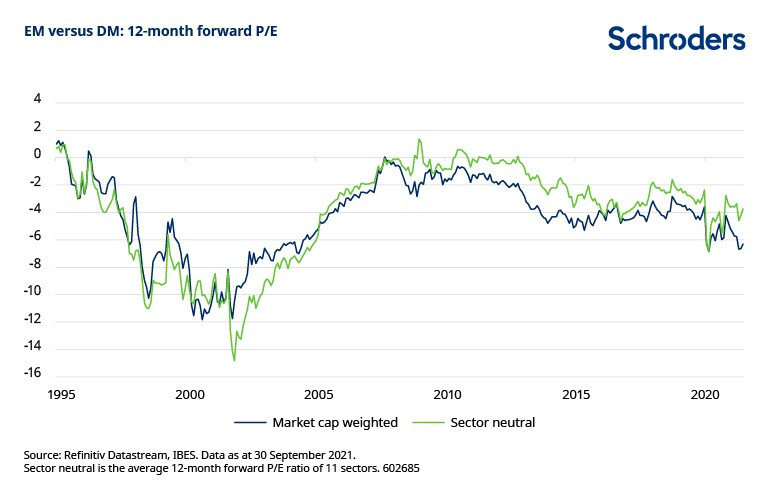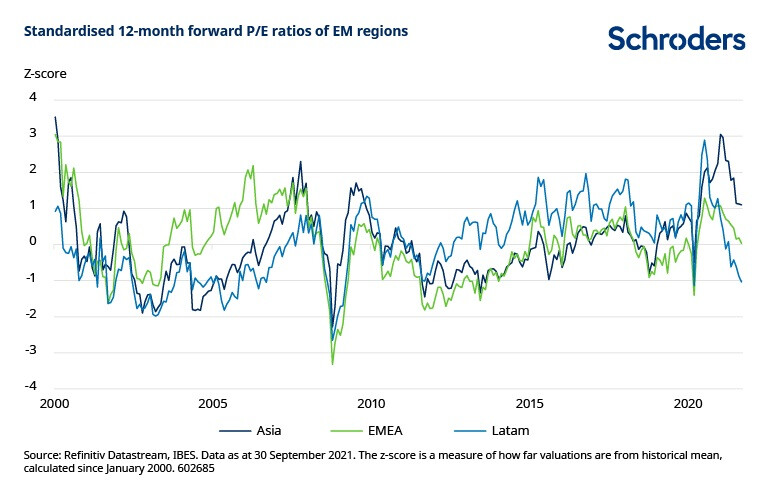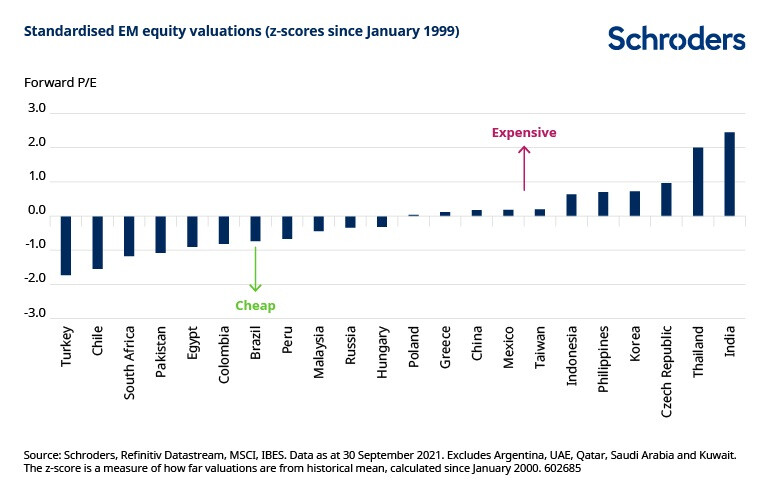Where is the value in emerging market equities?
There is more to EM equity valuations than meets the eye – we explain why.

Authors
Emerging market (EM) fundamentals are in better shape than most investors perhaps had feared early on in the Covid-19 pandemic, as we reviewed in July. Does this mean that EM as a whole offer an attractive investment opportunity?
Not necessarily, because, as is often the case in the financial markets, the attractiveness of assets is determined by the interplay between fundamentals and valuations.
And as we show, approaching EM valuations from a simple combined perspective does not provide an accurate picture of the current dynamics; these markets are far from homogenous
Our research paper - available here and at the foot of this article - incorporates a full assessment of emerging market valuations, from country through to sector, stock, style and currency analysis. Ultimately, this answers five key questions on EM valuations.
- Also read our new publication - Schroders Emerging Markets Lens - which helps investors track EM valuations.
Are emerging market equities cheap?
In short, not quite, at least relative to history. The 12-month forward price-to-earnings (P/E) ratio of the MSCI Emerging Markets Index stands at 12.8x (as at 31 September 2021), above the historical median of 11.6x.
Importantly, the forward P/E ratio has exhibited significant volatility in the pandemic, being affected by the swings in stock prices and expected earnings. Initially, the forward P/E ratio shot higher, reaching 16x in early 2021.
Since then, improving earnings expectations and falling EM stock prices have allowed the P/E ratio to come down from elevated levels. The question now is, can EM equities sustain these valuations?
The answer likely lies in the earnings outlook.
Crucially, earnings in many EM markets have stagnated because of the general lack of growth in EM. In other markets, valuation multiples imply elevated future growth expectations. For current EM equity valuations to be at least sustainable, EM earnings expectations would like have to continue to improve.

Do valuations vary between sectors?
There is considerable variability between the valuations of individual sectors. Some, such as real estate, energy, financials and materials, have forward P/E ratios of less than 10x. At the other end of the scale, consumer discretionary, consumer staples, communication services and health care sectors have P/E ratios of more than 20x. While the latter have historically traded at higher multiples than the former, they are also trading above their historical medians, indicating relatively poor valuations.
The MSCI Emerging Markets Value and Growth indices reflect a similar dispersion in valuations in EM. In early 2009, both indices had identical forward P/E ratios of 7x. Today, the value index has a forward P/E of 10x and the growth index a ratio of 20x. This divergence echoes the developments with value and growth stocks in the developed markets, where the gap between the two styles remains wide.
In sum, the divergences in sector and style valuations indicates that despite the elevated index level valuations, there may still be significant valuation opportunities in EM equites at a sector level.

Are EM equities cheap compared to DM equities?
Over the last decade, EM have persistently underperformed developed market (DM) equities. Has this dynamic resulted in a significant undervaluation of EM equities?
While the EM discount to DM has gradually increased over the last ten years, it is nowhere near as large as in the early 2000s, the end of the previous long period of EM underperformance.
In 2000, the EM discount was so large that the MSCI World Index traded at almost twice the forward P/E ratio of the MSCI Emerging Markets Index (24x vs 12x). Today, the difference is much lower (19x vs 13x). Furthermore, on a sector neutral basis, the advantage of EM over DM is even smaller.
Granted, in the early 2000s, many EM countries had double-digit interest rates, as persistently high inflation forced central banks to maintain very tight monetary policy. Since then, a structural decline in EM inflation has led to much lower EM interest rates, at least on average.
The relationship between equity valuations and interest rates is a complicated one, but generally, higher interest rates would require lower valuations and vice versa. So it would perhaps be unreasonable to expect EM equities to trade at a similar discount as 20 years ago.

Even though the EM/DM valuation gap does not imply extreme relative undervaluation of EM equities, can the EM discount still narrow? Based on past experience, this is possible, but again, EM fundamentals would likely have to do the heavy lifting.
Over the last decade, stagnating EM earnings and profitability have been a drag on relative valuations. Increasing commodity prices and the fast recovery in global trade have been silver linings in the pandemic for EM.
Nonetheless, to see a similar trend in EM earnings and profitability as in the early 2000s, would likely require a fundamental improvement in EM growth prospects.
Which EM regions and countries offer the best valuation opportunities?
Historically, the valuation of the three EM regions (Asia, EMEA1 and Latin America) have moved in the same direction, even if they have not always been in tune. However, the Covid-19 pandemic has opened up a noticeable divergence.
The forward P/E ratios of all three regions fell at the onset of the pandemic, but rebounded swiftly. Crucially, earnings in Asia recovered much faster than earnings in EMEA and Latin America. However, the increase in stock prices in Asia was even greater than the increase in expected earnings. As a result, valuations became very elevated in early 2021.
Since then, prices have fallen, impacted by the regulatory crack-down in China, which impacted a number of fast growing sectors. This has allowed the forward P/E to come down from 18x to 14x. Nonetheless, Asia’s gap to other regions and its own historical average remains significant.
The forward P/E ratio of Latin America has exhibited significant volatility but has now fallen to just 9x, well below its own historical average. The improvement in valuations has been supported by muted recovery in stock prices, as well as a significant rebound in earnings expectations on the back of higher commodity prices.
Finally, the P/E ratio of EMEA has been less volatile in the pandemic, currently standing at 10x. Compared to other regions, the recovery in earnings expectations has been the weakest in EMEA.

Finally, looking at the country-level valuations, there are large differences between the countries. The figure below shows the z-scores, a measure of how far valuations are from historical mean, of the members of the MSCI Emerging Markets Index.
Based on this measure, India and Thailand are the most expensive markets, whereas Turkey and Chile the cheapest markets.

How big is the value in EM currencies?
Since January 2011, EM equities have returned 103% in local currency terms, but only 51% in US dollars[1], reflecting the significant impact of depreciating EM currencies.
To asses the value in EM currencies, we calculated the real exchanges rates (RER) of the constituents of the MSCI Emerging Markets Index. The figure below shows how much the individual RERs deviate from the long-term (since January 1995) and the five-year average. It is clear that the value in EM currencies varies considerably. But in most countries, the currencies are below their historical average in real terms.
However, there are some exceptions, most significantly China and India, where currencies are above the long-term average. The Czech Republic and Egypt are the only countries with the real exchange rates above the long-term and the five-year average.
At the other end of the scale, Turkey, Brazil and Colombia have the cheapest currencies with the RERs 25% to 40% below the historical average.
Given that the MSCI Emerging Markets Index is heavily skewed towards Asia, especially three large north-east Asian markets of China, Korea and Taiwan, the value in EM currencies is more clear on the country, rather then the index level.

The views and opinions contained herein are those of Schroders’ investment teams and/or Economics Group, and do not necessarily represent Schroder Investment Management North America Inc.’s house views. These views are subject to change. This information is intended to be for information purposes only and it is not intended as promotional material in any respect.
Authors
Topics